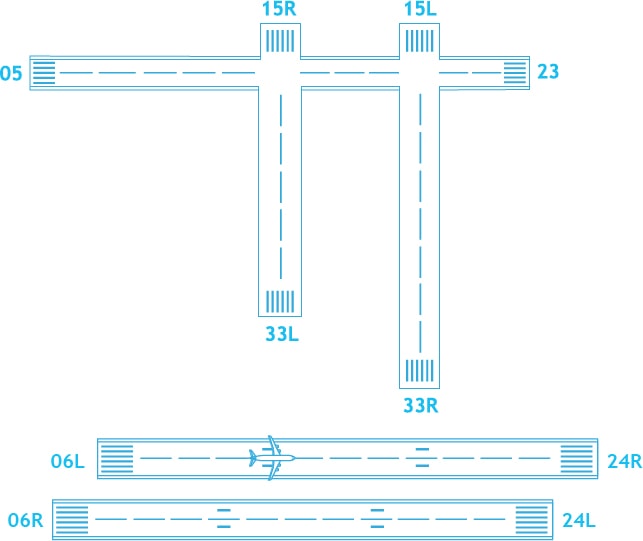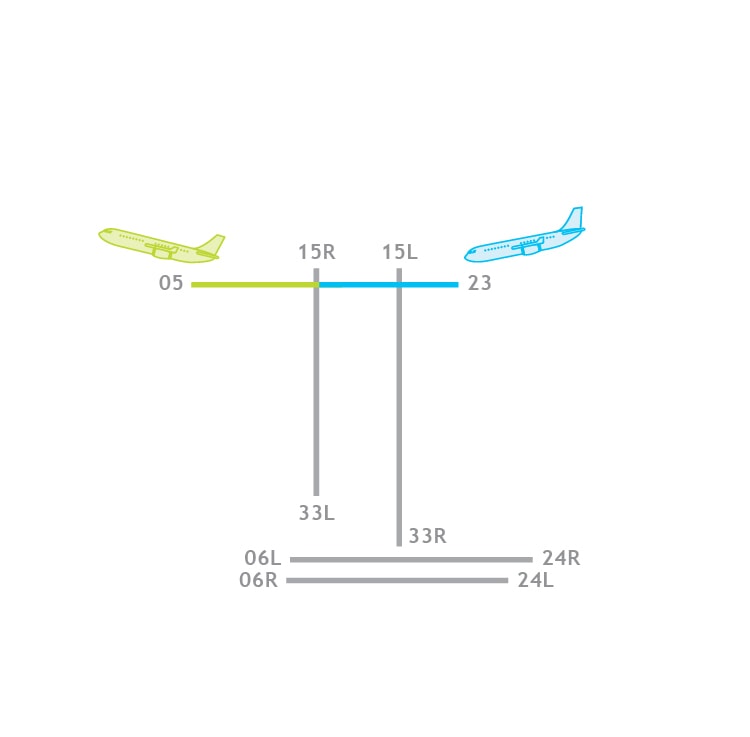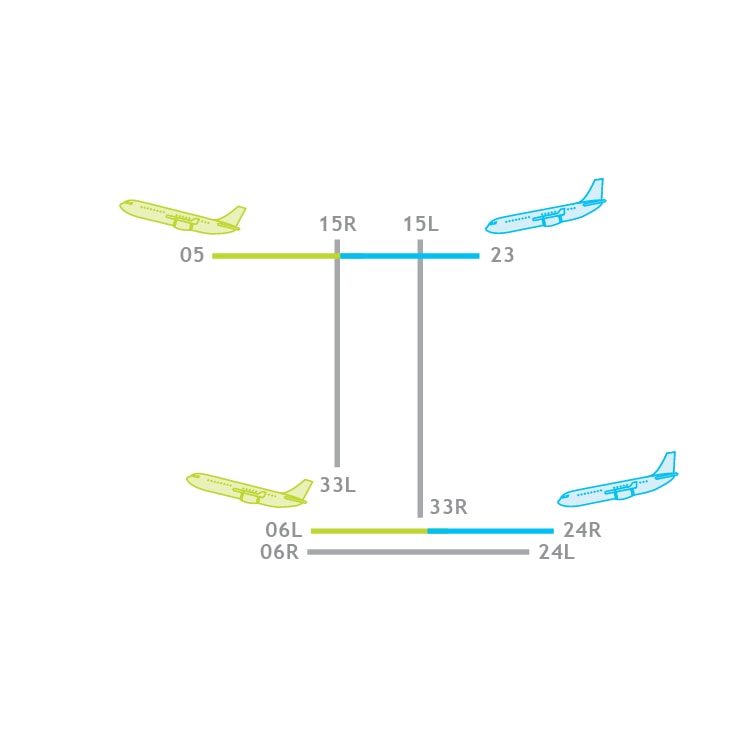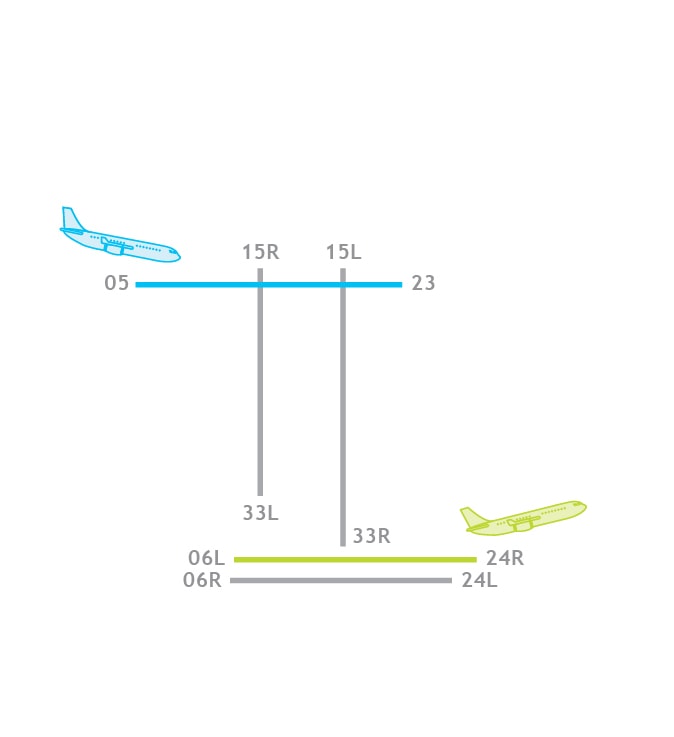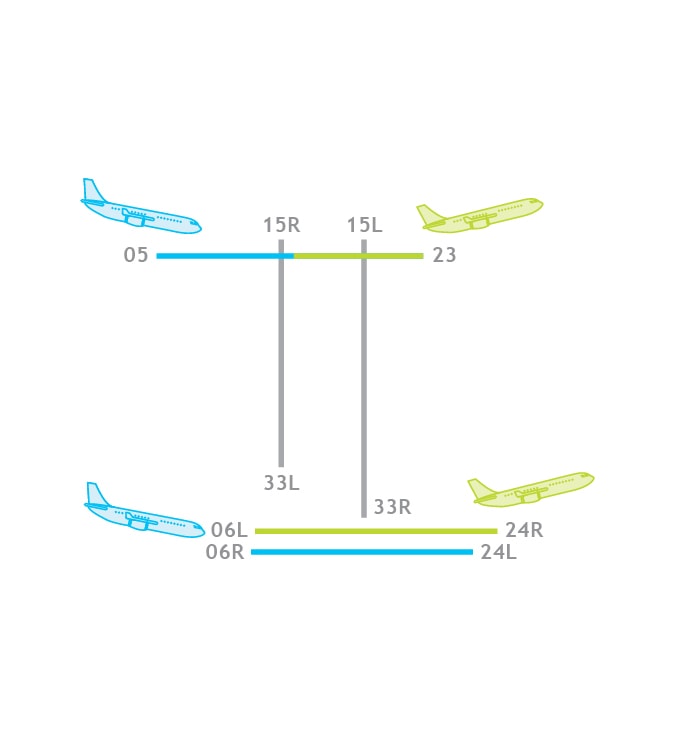Toronto Pearson runways
The Toronto Pearson airfield has five operational runways.
East-West runways:
- 05/23
- 06Right (R)/24Left (L)
- 06L/24R
North-South runways:
- 15R/33L
- 15L/33R
Runways are labelled by the first two digits of the compass bearing. These designations correspond to the direction the airplane is heading towards during landing. When more than one runway points in the same direction, the runways are labelled Left (L) or Right (R).
If an aircraft departs from, or arrives on Runway 24L or 24R, it is on a westerly heading. This means that the aircraft would be departing to the west, or arriving from the east towards the west.
Runways are required to have an area adjacent to the end of the strip set aside for Runway End Safety Areas (RESA).
At times, to accommodate traffic the dedicated departure runway can also be used for arrivals when there are gaps in departure traffic and vice-versa.
Factors affecting how runways are assigned
Runways are assigned based on a number of factors:
- Wind direction and wind speed
- Weather
- Runway conditions/availability
- Type of aircraft
- Operational efficiency
- Time of day
As the prevailing winds are from the west, the most common runway configuration at Toronto Pearson supports a westerly flow, which means arrivals from the east and departures to the west using Runways 23, 24L, 24R. The second most common configuration supports an easterly flow - arrivals from the west and departures to the east using Runways 05, 06L and 06R.
When wind speed reaches a point where it is no longer safe for aircraft to land and depart in one of these directions, the runways are re-assigned to allow aircraft to land and depart into the wind. It is important to note that runway conditions are also a factor. Friction is reduced in wet or snow covered runway conditions and so a lower wind speed level will prompt an ‘into the wind’ runway assignment than when operating in dry runway conditions.
Runways are required to have an area adjacent to the end of the strip set aside for Runway End Safety Areas (RESA). How much of the runway pavement that has to be used for this purpose depends on what lays beyond the end of each runway. For example, if there is a field at the end of the runway, this can count towards the RESA, allowing more of the pavement to be used for operations.
Runway 15L/33R is our longest runway in terms of the total available pavement for take-off, known as the Take Off Run Available (TORA). This is because less of the actual runway pavement is required to be reserved as a RESA because the surface beyond these runway ends is usable as a RESA, as per Transport Canada’s standard.
We tend to use the East-West configuration most often because the prevailing winds at Toronto Pearson blow in an East-West direction, and also because the three East-West runways provide us with more capacity. We most often use the North-South configuration when weather necessitates it or to accommodate airfield maintenance/construction. Runway 15L/33R is also part of our night-time preferential runway system.
Runway configurations and operating modes
Runways can be used in a mixed-mode or dedicated-mode.
- Dedicated-mode – when a runway is used exclusively for arrivals or departures
- Mixed-mode – when a runway is used for both landings and departures at the same time
We can use our five runways in many different configurations, some of which provide us with more capacity than others.
Straight or single runway configuration is when we use just one of our five runways to support a mix of arrivals and departures.
For example, using only Runway 23 for both arriving and departing aircraft. In this case, we would say that we’re on a single runway configuration using Runway 23 in a mixed-mode. We can use this configuration during periods of low traffic, when a single runway can handle the capacity.
Land 1/Depart 1 configuration is when one runway is used for arrivals, and the other for departures. In this case, each runway is being used in a dedicated-mode. For example, using Runway 33R for arrivals and Runway 33L for departures.
At times, to accommodate traffic the dedicated departure runway can also be used for arrivals when there are gaps in departure traffic and vice-versa. We call these offloads.
Dual runway configuration is when two parallel runways are used simultaneously and independently with both runways being used in a mixed-mode.
At Toronto Pearson, this can be done by using Runway 05/23 and 06L/24R or 05/23 and 06R/24L. Runways 06L/24R and 06R/24L cannot be used for a dual configuration because of their proximity to each other.
Triple runway configuration is when all three east/west runways are used, with one runway used in a mixed-mode and the other two in dedicated-modes. For example, using Runway 23 in mixed-mode, and then using Runway 24R for departures and Runway 24L for arrivals.
Our throughput rate (the number of arrivals and departures) is greatest when we’re on a triple configuration, followed by a dual configuration. In periods of low traffic, we can operate in a single or a Land 1/Depart 1 configuration.
Why is this important?
Our north/south runways can’t be used in a dual mode because of their proximity to one another, which means our capacity is impacted when we are on that configuration.
Learn more about how Toronto Pearson operates.

